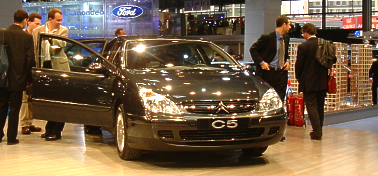
.
. .
..
. . .
Related Topics:
© 1998 - 2006 Copyright & |
A stylish tourer of luxurious design and cutting-edge technology The CitroŽn C5 is the latest illustration of the brand's renewed vitality, expressed notably by the Xsara Picasso, the C3 and C6 concept cars and the Pluriel demonstrator vehicle. Reflecting the same strategy, the C5 features innovations in styling, architecture, living space and technological content. The styling of the C5, designed to evoke power, vitality and strength, is the work of CitroŽn's Styling Centre. Through its proportions, and more particularly its exceptional height - this being the most visible illustration of the new architecture - the C5 breaks with conventional saloon styling to take a major step forward in concepts of saloon design.
Consumer requirements have changed considerably since the start of the 1990s, particularly with respect to interior space, comfort and safety. In this way, the external dimensions of the CitroŽn C5 place it at the top end of the M2 (upper mid-range) segment on the borderline with the H (luxury) segment. In terms of length and width (4.62 m and 1.77 m respectively), the C5 is closer to the XM than the Xantia, but its real originality lies in its height (1.48 m). These dimensions and the flat floor pan make the C5 more spacious than any vehicle to date in this segment. It combines a range of storage compartments with a vast boot (456 dm3). The large volume also provides space for a semi-raised driving position, offering increased comfort and a improved view of the road. Technology also features strongly in the CitroŽn C5, which offers a host of customer benefits. The 3rd generation Hydractive suspension sets new standards in comfort and road holding. Its intelligent control system manages the two suspension settings, comfort and dynamic, to vary springing and damping simultaneously as necessary. Moreover, the new-generation suspension is fitted with an innovative function that adapts the height of the vehicle to its speed. This function improves stability by lowering the centre of gravity (by 15 mm at the front and 11 mm at the rear) and reducing fuel consumption. When the road surface is badly damaged, vehicle height can increase by 13 mm. A system of innovative design, 3rd generation Hydractive requires no maintenance for the first 5 years or 200,000 km.
The C5 also uses multiplex electrics, paving the way for innovative functions offering increased comfort and safety such as : black panel function, automatic windscreen wipers, multifunctional onboard computer, automatic lights and hazard warning lights, detection of low tire pressure and satellite navigation. The C5 boasts the latest in onboard technology. The pursuit of optimized safety, both active and passive, remains a central concern at CitroŽn. With its 3rd generation Hydractive suspension and wide range of safety equipment (including ABS, emergency braking assistance, traction control and six airbags of which two are curtain), the C5 becomes the new safety benchmark in its segment. The C5 reflects a new naming policy, which goes hand in hand with the revitalization of the brand CitroŽn. The names based on this new approach include the letter C and a figure. The letter marks them as belonging to the CitroŽn family, while the figure indicates their position in the range. These names give the brand a higher profile and set its models further apart from the names used by the competition. Initiated in 1998 with the C3 concept car, this policy was continued in 1999 with the presentation of the C6. The positive response from members of the public and automotive specialists confirmed the choices made. This approach also reflects the history of the brand, which baptized two models C4 and C6 in 1928. Moreover, this new policy will make it possible to give personalized names to models with specific targeting, for example the Pluriel.
As of the launch date, the range comprises two levels of trim and two new engines: the 136 bhp 2.2 HDi equipped with the particle filter (PF), and the 210 bhp 3.0 V6. Both can be coupled to a manual gearbox or a sequential control auto-active automatic gearbox. Other powerplants will become available at a later date (the 2.0 HDi, 2.0i petrolÖ). At the same time, a Xantia range with a limited number of models will remain in production. The CitroŽn C5 was developed in three years in line with CitroŽn's product development charter. The first vehicle to be developed following the reorganization of the PSA Peugeot CitroŽn Group, the C5 is the first use of platform 3. This will be the basis for all vehicles in the M2 and H segments, notably CitroŽn's luxury model heralded by the C6. A total FF 6.9 billion (3 1.05 billion) was invested for the C5 programme as a whole, of which FF 3.2 billion (3 488 million) in development costs. The installed production capacity at the Rennes-la-Janais site over a full year is 920 vehicles/day, of which almost one-third will be for France.
|
. |












